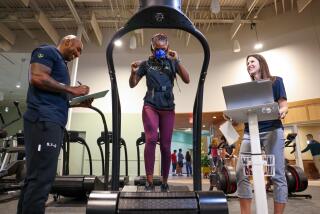A Picture of Health: The Worried Well
Medical private practice in Los Angeles has some unique features. We Angelenos fear the occasional earthquake, drought and fire, along with the more frequent wrinkles, subcutaneous fat and less than perfect health. Since we cant do much about the earths surprises, we seek more control of our own bodies. Nowadays, this means patients crave the latest, often most expensive, tests money (or insurance) can buy.
Sometimes even I find it hard to separate my role as physician from that of medical consumer. When I read about new diagnostic tests or statistics on the prevalence and morbid outcomes of diseases that could have been diagnosed if only..., I, too, wonder if I should run to a radiology center for the latest scan or proffer my blood for innovative analysis.
The term worried well has become applicable to many of my patients, friends and family. (I come from a long line of hypochondriacs.) As the media bombard us with the newest in diagnostics (simple, painless, miraculousyou dont want to miss this test) and the Internet lets us bring up hundreds of disease and treatment possibilities, people feel a need to keep up and check up, and it has become hard for physicians to just say no: No, you dont need that test, and no, I wont order it.
L.A. boasts one of the widest ranges of medical services available in this country. And we use them, contributing our part to the current cost of medical care, estimated to average $7,500 a person annuallyabout twice that of other developed countries, where health and longevity rates are higher!
West Coast living has conditioned us to seek the most hyped approaches to our health. A study is performed on a dozen or so rodents, and we are told it can have astounding implications. But lets remember to ask the important questions: Do the medicalized rats represent humans? And if the study did deal with humans, did patients feel better, live longer or survive the disease? We feel a get-with-it imperative. And if a celebrity takes the test or medication to heart (literally and figuratively), then it is certainly appropriate.
Here are a few tests doctors are asked to perform by patients with no symptoms or personal risk, who worry that they have an undiagnosed disastrous disorder. Are they worth itand will they make the worried well?
Breast MRI
This is a highly sensitive exam that picks up changes in blood-vessel formation induced in breast tissue in order to feed a tumor (called neovascularization). Some of these lesions can be missed by a mammogram. There is no radiation or potential danger from an MRI. However, tissue abnormalities that are not cancer (false positives) may occur, causing unwarranted biopsies. The cost ranges from $1,200 to upwards of $7,000 (depending on whether you pay cash or your insurance is billed).
The recommendation now used by most insurance companies to gauge reimbursement is that a yearly MRI be done on those who: Are at high risk for breast cancer (as in, they have the breast-cancer-gene mutation or a family history of breast and/or ovarian cancer).
Have been diagnosed with breast cancer (MRI would search for areas of cancer that may have been missed by a mammogram).
Have had radiation for Hodgkins disease before the age of 30. One in eight women will develop breast cancer. So, should patients have routine breast MRIs to screen for cancer? Probably not until the cost goes down and the accuracy and number of machines and trained technologists goes up.
CT Scan
Computerized tomography renders a 3-D view of internal organs. Hundreds of X-ray slices are taken as the source rotates.
Its fast, painless and lets the radiologist see your inner depths. But youre exposed to levels of radiation far greater than that of a single chest X-ray, and it can cause DNA damage in your cells. This potential collateral damage may be worthwhile if your doctor feels it might diagnose a disease for which you have symptoms. But to do it just to see may ultimately increase your chances of getting the disease you fear mostcancer.
Many cardiologists order a heart CT scan to check for calcium deposits in coronary plaque or diagnose strictures of the vessels. A new superfast 64-slice or angio CT scan gives a real-time see-everything video of the heart in motion.
There is disagreement as to whether this adds information to well-established and less radiating tests. The cost ranges from about $1,500 for a cash procedure to some $6,000 through insurance.
I had a heart scan about six years ago, which I reported on for The Today Show. But I am concerned about the cumulative radiation in those who have them repeatedly just to see how they are doing.
Former smokersor, heaven forbid, those who havent quitare often told they can ensure no harm was done with a lung CT scan. There is evidence that this test (and not a simple chest X-ray) can detect early cancers in smokers of one or more packs for 20 or more years. At-risk patients have valid concerns, so I do lung CTs on request, after warning about the worrisome and possibly invasive consequences of false positives.
Now, what about that virtual colonoscopy? Doesnt everyone over 50 need a colon screening? Yes, and this form of abdominal CT scan can find most polyps and tumors when combined with a bowel prep (think major laxatives) and air injected into the rectum. But the radiation can be equivalent to 1,000 chest X-rays, and a real colonoscopy and biopsy would be necessary if something is found during the virtual procedure.
Before I sound like a medical Scrooge, let me list the tests that are considered the gold standard for evidence-based medical care:
Pap smears in women over 21 (earlier if sexually active for three years).
Mammograms in women over 40.
Blood pressure at any age.
Cholesterol tests at any age (glucose depending on history or obesity). HIV testing.
Colonoscopy after 50.
PSA test in men over 50 (sometimes questioned by experts).
Most important, a good hands-on exam and discussion of your lifestyle and history with your medical practitioner.
To healthyours and mine!
Dr. Judith Reichman, a leading voice in womens health, has an OB-GYN practice in L.A. Her latest book is Slow Your Clock Down: A Womens Complete Guide to a Younger, Healthier You.
More to Read
Sign up for The Wild
We’ll help you find the best places to hike, bike and run, as well as the perfect silent spots for meditation and yoga.
You may occasionally receive promotional content from the Los Angeles Times.










